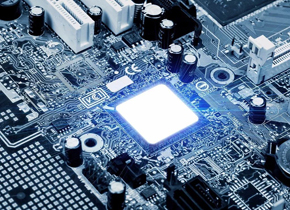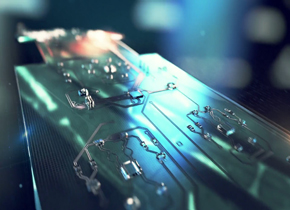Time: 2021-08-06 View: 585
At present, electronic equipment is still used in various electronic equipment and systems with printed circuit boards as the main assembly method. Practice has proved that even if the circuit schematic design is correct and the printed circuit board is not properly designed, it will adversely affect the reliability of electronic equipment. For example, if two thin parallel lines of the printed board are close together, it will cause a delay in the signal waveform, and reflection noise will be formed at the end of the transmission line. Therefore, when designing a printed circuit board, care should be taken to adopt the correct method.
1. Ground wire design In electronic equipment, grounding is an important method to control interference
If the grounding and shielding can be properly combined and used, most of the interference problems can be solved. The ground structure of electronic equipment roughly includes system ground, chassis ground (shield ground), digital ground (logical ground), and analog ground. The following points should be paid attention to in the ground wire design:
1. Correctly choose single-point grounding and multi-point grounding. In low-frequency circuits, the operating frequency of the signal is less than 1MHz, and the inductance between its wiring and devices has little effect, and the circulating current formed by the grounding circuit has a greater impact on interference, so it should be used One point is grounded. When the signal operating frequency is greater than 10MHz, the ground wire impedance becomes very large. At this time, the ground wire impedance should be reduced as much as possible, and the nearest multiple points should be used for grounding. When the working frequency is 1~10MHz, if one-point grounding is used, the length of the ground wire should not exceed 1/20 of the wavelength, otherwise the multi-point grounding method should be used.
2. Separate the digital circuit from the analog circuit. There are both high-speed logic circuits and linear circuits on the circuit board. They should be separated as much as possible, and the ground wires of the two should not be mixed, and they should be connected to the ground wires of the power supply terminal. Try to increase the grounding area of the linear circuit as much as possible.

3. Thicken the grounding wire as much as possible. If the grounding wire is very thin, the ground potential will change with the change of current, resulting in unstable timing signal level of electronic equipment and deterioration of anti-noise performance. Therefore, the grounding wire should be as thick as possible so that it can pass the allowable current on the printed circuit board. If possible, the width of the grounding wire should be greater than 3mm. 4. When the grounding wire is formed into a closed loop, when designing a grounding system of a printed circuit board composed of only digital circuits, making the grounding wire into a closed loop can significantly improve noise immunity. ability. The reason is that there are many integrated circuit components on the printed circuit board, especially when there are components that consume more power, due to the limitation of the thickness of the ground wire, a large potential difference will be generated on the ground junction, which will cause the anti-noise ability to decrease. , If the grounding structure is formed into a loop, the potential difference will be reduced and the anti-noise ability of electronic equipment will be improved.
2. Electromagnetic compatibility design
Electromagnetic compatibility refers to the ability of electronic equipment to work in a coordinated and effective manner in various electromagnetic environments. The purpose of electromagnetic compatibility design is to enable electronic equipment to suppress all kinds of external interference, so that the electronic equipment can work normally in a specific electromagnetic environment, and at the same time to reduce the electromagnetic interference of the electronic equipment itself to other electronic equipment.
1. Choose a reasonable wire width. Since the impact interference generated by the transient current on the printed lines is mainly caused by the inductance of the printed wires, the inductance of the printed wires should be minimized. The inductance of the printed wire is proportional to its length and inversely proportional to its width, so short and precise wires are beneficial to suppress interference. The signal lines of clock leads, row drivers or bus drivers often carry large transient currents, and the printed wires should be as short as possible. For discrete component circuits, when the printed wire width is about 1.5mm, it can fully meet the requirements; for integrated circuits, the printed wire width can be selected between 0.2mm and 1.0mm.
2. Adopt the correct wiring strategy. The use of equal routing can reduce the wire inductance, but the mutual inductance and distributed capacitance between the wires increase. If the layout permits, it is best to use a grid-shaped wiring structure. The specific method is to wire one side of the printed board horizontally and the other side of the printed board. Then connect with metallized holes at the cross holes.
In order to suppress the crosstalk between the conductors of the printed circuit board, when designing the wiring, you should try to avoid long-distance equal wiring, extend the distance between the wires as much as possible, and try not to cross the signal wires with the ground wires and the power wires. Setting a grounded printed line between some signal lines that are very sensitive to interference can effectively suppress crosstalk.
In order to avoid electromagnetic radiation generated when high-frequency signals pass through the printed wires, the following points should also be noted when wiring the printed circuit board:
● Minimize the discontinuity of printed wires, for example, the width of the wires should not change suddenly, and the corners of the wires should be greater than 90 degrees to prohibit looping.
●The clock signal lead is most likely to produce electromagnetic radiation interference. When routing the wire, it should be close to the ground loop, and the driver should be close to the connector.
●The bus driver should be close to the bus to be driven. For those leads that leave the printed circuit board, the driver should be next to the connector.
●The wiring of the data bus should clamp a signal ground wire between every two signal wires. It is best to place the ground loop next to the least important address lead, because the latter often carries high-frequency currents.
●When arranging high-speed, medium-speed and low-speed logic circuits on the printed circuit board, devices should be arranged
3. Suppress reflection interference. In order to suppress the reflection interference that appears at the terminal of the printed line, in addition to special needs, the length of the printed line should be shortened as much as possible and a slow circuit should be used. Terminal matching can be added when necessary, that is, a matching resistor of the same resistance is added to the end of the transmission line to the ground and the power terminal. According to experience, for general faster TTL circuits, terminal matching measures should be adopted when the printed lines are longer than 10cm. The resistance value of the matching resistor should be determined according to the maximum value of the output drive current and the absorption current of the integrated circuit.

Three, decoupling capacitor configuration
In the DC power supply loop, the change of the load will cause the power supply noise. For example, in digital circuits, when the circuit changes from one state to another, a large spike current will be generated on the power line, forming a transient noise voltage. The configuration of decoupling capacitors can suppress the noise generated by load changes, which is a common practice in the reliability design of printed circuit boards. The configuration principles are as follows:
●Connect a 10-100uF electrolytic capacitor across the power input. If the location of the printed circuit board allows, the anti-interference effect of using an electrolytic capacitor above 100uF will be better.
● Configure a 0.01uF ceramic capacitor for each integrated circuit chip. If the printed circuit board space is small and cannot be installed, one 1-10uF tantalum electrolytic capacitor can be configured for every 4-10 chips. The high-frequency impedance of this device is particularly small.